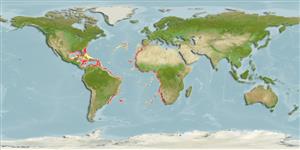Teleostei (teleosts) >
Notacanthiformes (Halosaurs and deep-sea spiny eels) >
Halosauridae (Halosaurs)
Etymology: Halosaurus: Greek, als, alis = salt + Greek, sauros = lizard (Ref. 45335).
Environment: milieu / climate zone / depth range / distribution range
Ecology
Marine; bathydemersal; depth range 440 - 1700 m (Ref. 4448). Deep-water; 38°N - 35°S, 98°W - 20°E
Eastern Atlantic: Azores and Morocco to South Africa, including western Mediterranean (off Algeria). Western Atlantic: Gulf of Mexico, Caribbean, and off Lesser Antilles.
Size / Weight / Age
Maturity: Lm ? range ? - ? cm
Max length : 60.0 cm TL male/unsexed; (Ref. 4448)
Dorsal
spines
(total): 1;
Dorsal
soft rays
(total): 8-9. Body is compressed (Ref. 37108). Pinkish with silvery reflections, darker dorsally (Ref. 3974). Lacks the checkerboard pattern of whitish and brown, produced by concentration of pigment at the margins of the scale pockets (Ref. 37108).
The shallowest-occurring halosaur in the Atlantic. May form aggregations. Feeds on polychaetes, sipunculids, crustaceans and fish.
Life cycle and mating behavior
Maturity | Reproduction | Spawning | Eggs | Fecundity | Larvae
Sulak, K.J., 1990. Halosauridae. p. 126-132. In J.C. Quero, J.C. Hureau, C. Karrer, A. Post and L. Saldanha (eds.) Check-list of the fishes of the eastern tropical Atlantic (CLOFETA). JNICT, Lisbon; SEI, Paris; and UNESCO, Paris. Vol. 1. (Ref. 4448)
IUCN Red List Status (Ref. 130435)
Threat to humans
Harmless
Human uses
More information
ReferencesAquacultureAquaculture profileStrainsGeneticsElectrophoresesHeritabilityDiseasesProcessingNutrientsMass conversion
Tools
Special reports
Download XML
Internet sources
Estimates based on models
Preferred temperature (Ref.
123201): 4.2 - 11, mean 6.3 °C (based on 255 cells).
Phylogenetic diversity index (Ref.
82804): PD
50 = 0.5020 [Uniqueness, from 0.5 = low to 2.0 = high].
Bayesian length-weight: a=0.00087 (0.00033 - 0.00229), b=3.07 (2.84 - 3.30), in cm total length, based on LWR estimates for this (Sub)family-body shape (Ref.
93245).
Trophic level (Ref.
69278): 3.5 ±0.48 se; based on food items.
Resilience (Ref.
120179): Medium, minimum population doubling time 1.4 - 4.4 years (Preliminary K or Fecundity.).
Fishing Vulnerability (Ref.
59153): Moderate vulnerability (44 of 100).
